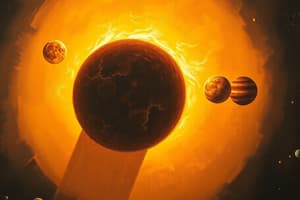Podcast
Questions and Answers
What is the predicted remaining lifespan of the Sun?
What is the predicted remaining lifespan of the Sun?
- 3 billion years
- 5 billion years (correct)
- 8 billion years
- 10 billion years
Which planet is known as Earth's twin due to its mass and size?
Which planet is known as Earth's twin due to its mass and size?
- Mars
- Venus (correct)
- Mercury
- Jupiter
What unique orbital characteristic does Venus have compared to other planets in the Solar System?
What unique orbital characteristic does Venus have compared to other planets in the Solar System?
- It has a retrograde orbit (correct)
- It has an inclined orbit
- It orbits in a circular pattern
- It has an elliptical orbit
What is the primary component of Earth's atmosphere that supports life?
What is the primary component of Earth's atmosphere that supports life?
Which planet has the highest recorded surface temperature?
Which planet has the highest recorded surface temperature?
What is the significance of the Goldilocks Zone?
What is the significance of the Goldilocks Zone?
What is a defining characteristic of Mercury's surface?
What is a defining characteristic of Mercury's surface?
What is the primary reason Earth is referred to as 'The Blue Planet'?
What is the primary reason Earth is referred to as 'The Blue Planet'?
What is the predicted fate of Deimos, one of Mars' moons?
What is the predicted fate of Deimos, one of Mars' moons?
Which of the following statements accurately describes Olympus Mons?
Which of the following statements accurately describes Olympus Mons?
What is the primary composition of Jupiter's atmosphere?
What is the primary composition of Jupiter's atmosphere?
How is the Red Spot on Jupiter best described?
How is the Red Spot on Jupiter best described?
What is hypothesized to be the cause of the formation of the Asteroid Belt?
What is hypothesized to be the cause of the formation of the Asteroid Belt?
Which of the following moons of Jupiter has a surface that is always changing?
Which of the following moons of Jupiter has a surface that is always changing?
What characteristic is notable about Saturn's rings?
What characteristic is notable about Saturn's rings?
Which moon of Saturn is recognized for having a dense atmosphere?
Which moon of Saturn is recognized for having a dense atmosphere?
Flashcards are hidden until you start studying
Study Notes
Central Star - The Sun
- The Sun is the brightest star in the Solar System and has existed for about 4.6 billion years, with an estimated 5 billion years remaining.
- Emits various types of electromagnetic radiation, including ultraviolet waves, radio waves, gamma rays, X-rays, microwaves, and infrared rays.
Inner Planets
Mercury
- Named after the Greek messenger god Hermes.
- Orbital period: 88 Earth days; rotational period: 58 Earth days.
- Surface temperature ranges from 427°C (day) to -173°C (night).
- Known as the morning and evening star; it has no moons or atmosphere due to proximity to the Sun.
Venus
- Named after the Greek goddess of beauty, Aphrodite.
- Orbital period: 255 Earth days; rotational period: 243 Earth days (retrograde rotation).
- Surface temperature reaches about 482°C.
- Earth’s twin in mass and size, with a thick atmosphere rich in carbon dioxide and active volcanoes under cloud cover.
Earth
- Named after the primordial deity Gaia.
- Orbital period: 365 days; rotational period: 24 hours.
- Average surface temperature: 15°C.
- Known as the "Blue Planet" due to its water-covered surface and is the only known planet to support life, benefiting from a multilayered atmosphere with oxygen.
Mars
- Named after the Greek god of war, Ares.
- Orbital period: 687 days; rotational period: 24.6 hours.
- Known as the "Red Planet" due to oxidized iron on its surface.
- Features Olympus Mons (the largest volcano) and Valles Marineris (the largest canyon).
- Has two moons: Deimos (farther away, predicted to escape Mars's gravity) and Phobos (predicted to crash into Mars).
Asteroid Belt
- The boundary between the inner and outer planets, consisting of a collection of planetary debris.
- Theories suggest it may consist of remnants from a destroyed planet or leftover materials from the Solar System's formation.
- Asteroids become meteors upon atmospheric entry and meteorites upon disintegration.
Outer or Jovian Planets
Jupiter
- The largest planet, named after the Greek god Zeus.
- Its atmosphere is primarily hydrogen, containing a persistent storm system called the Great Red Spot, which measures 25,000 km in diameter.
- Hosts 62 moons; notable ones include Ganymede (largest, comparable to a planet), Callisto (atmosphere of carbon dioxide and molecular oxygen), Io (geologically active), and Europa (features a frozen ocean).
Saturn
- The second-largest planet, named after the titan Cronus (Kronos).
- Famous for its extensive rings composed of ice and rock, divided into three groups, including the Cassini Division.
- Its atmosphere includes hydrogen, helium, ammonia, methane, and water, with wind speeds reaching approximately 1770 km/h.
- Hosts 24 moons; Titan is the largest, known for its dense atmosphere.
Studying That Suits You
Use AI to generate personalized quizzes and flashcards to suit your learning preferences.




